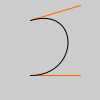bezier()#
Draws a Bezier curve on the screen.
Examples#

def setup():
py5.no_fill()
py5.stroke(255, 102, 0)
py5.line(85, 20, 10, 10)
py5.line(90, 90, 15, 80)
py5.stroke(0, 0, 0)
py5.bezier(85, 20, 10, 10, 90, 90, 15, 80)

def setup():
py5.no_fill()
py5.stroke(255, 102, 0)
py5.line(30, 20, 80, 5)
py5.line(80, 75, 30, 75)
py5.stroke(0, 0, 0)
py5.bezier(30, 20, 80, 5, 80, 75, 30, 75)
Description#
Draws a Bezier curve on the screen. These curves are defined by a series of anchor and control points. The first two parameters specify the first anchor point and the last two parameters specify the other anchor point. The middle parameters specify the control points which define the shape of the curve. Bezier curves were developed by French engineer Pierre Bezier. Using the 3D version requires rendering with P3D.
Underlying Processing method: bezier
Signatures#
bezier(
x1: float, # coordinates for the first anchor point
y1: float, # coordinates for the first anchor point
x2: float, # coordinates for the first control point
y2: float, # coordinates for the first control point
x3: float, # coordinates for the second control point
y3: float, # coordinates for the second control point
x4: float, # coordinates for the second anchor point
y4: float, # coordinates for the second anchor point
/,
) -> None
bezier(
x1: float, # coordinates for the first anchor point
y1: float, # coordinates for the first anchor point
z1: float, # coordinates for the first anchor point
x2: float, # coordinates for the first control point
y2: float, # coordinates for the first control point
z2: float, # coordinates for the first control point
x3: float, # coordinates for the second control point
y3: float, # coordinates for the second control point
z3: float, # coordinates for the second control point
x4: float, # coordinates for the second anchor point
y4: float, # coordinates for the second anchor point
z4: float, # coordinates for the second anchor point
/,
) -> None
Updated on March 06, 2023 02:49:26am UTC
